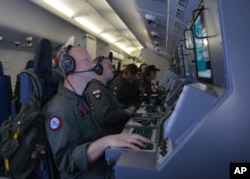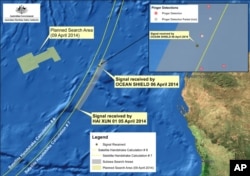Search crews have detected more underwater transmissions they believe could belong to the flight data recorder of the missing Malaysian jetliner.
Australian authorities said an Orion surveillance aircraft heard a "possible signal" Thursday in the southern Indian Ocean, near where ships heard similar sounds earlier this week.
Search chief Angus Houston said in a statement "the acoustic data will require further analysis overnight, but shows potential of being from a man-made source."
Houston, who is coordinating the search, on Wednesday said he hopes the developments mean authorities can find the missing Boeing 777 "in the not too distant future."
Time running out
The pings have helped greatly narrow the search area. But on Thursday, planes and ships continued searching a region stretching 57,000 square kilometers.
Time is running out for authorities to locate the origin of the signals, since the batteries on the black box's locator beacon are set to run out after about 30 days.
The Malaysia Airlines jet, which was carrying 239 people, disappeared on March 8 while traveling from Kuala Lumpur to Beijing.
Malaysian authorities believe the plane was deliberately diverted and crashed into the sea. But without wreckage, many are skeptical.
In the Malaysian capital Thursday, salesman Wee Boon Seow said it is hard to be optimistic that search crews are narrowing in on the plane.
"I mean, as a Malaysian, we tend to take everything with a pinch of salt, because there is always this latest development, this latest news about how they discovered the 'pings' in the south Indian Ocean. But I don't know. I'm pretty pessimistic about the news," he said.
Huge international search effort
A total of 14 planes and 13 ships are involved in Thursday's search for the plane, which extends from about 2,300 kilometers northwest of the Australian city of Perth.
If authorities can locate more pings, they plan to deploy a robot submarine to search the ocean floor.
Once the black box is retrieved, authorities will be able to determine what happened to the plane. Its fate has become one of the most puzzling mysteries in modern aviation.
The plane vanished without any distress calls, and authorities have refused to rule out any possibilities, including hijacking, sabotage or a mechanical malfunction.
Low-tech takes center stage
The search for missing Malaysia Airlines Flight MH370 may be using some of the world's most sophisticated tools, but some decidedly low-tech gear still has a major role in cracking one of modern aviation's great mysteries.
While the U.S. Navy's P-8 Poseidon surveillance plane scours the Indian Ocean below with top-secret cameras and sensors, older technologies, such as sonobuoys, as well as divers and human eyesight, are emerging as crucial to the operation.
"With all the technology we have, nothing is as important as looking at things with your eyes," U.S. Navy Lieutenant Ken Savage told Reuters during a recent search flight on one of two Poseidons helping with the multi-national effort.
The Malaysia Airlines Boeing 777 jetliner vanished on March 8 en route from Kuala Lumpur to Beijing, carrying 227 passengers and 12 crew. In the most expensive search operation in aviation history, neither satellite nor sensor has yet found any wreckage.
That's where the human factor comes in, says David Mearns, a deep sea search and recovery expert who was involved in the search for Air France Flight 447, which crashed in the Atlantic Ocean in 2009.
"Even though it may look simple and rudimentary compared to the undersea work, it's still very important," he said, referring to the visual searches that are key to the mission.
"At the end of the day, it's left to eyes on water and men and women to be able to pluck wreckage out of the sea. Those methods are still extremely valid."
Keep quiet out there
A sophisticated U.S. Navy "Towed Pinger Locator" (TPL) has recently picked up four "pings" consistent with black box locator beacons, helping to narrow the search area and inspiring fresh confidence in the search.
But the deep ocean is a very noisy place, prompting Australia this week to deploy a World War II-era technology, the sonobuoy, to help the TPL search for the black box recorders.
All 84 sonobuoys are equipped with a hydrophone listening device, which is dangled some 1,000 feet (305 meters) below the surface and can transmit data to search aircraft via radio signals.
Crucially, the sonobuoys are quiet where higher-tech search planes and ships might interfere with the delicate task.
"That does provide a lot of sensors in the vicinity of the Ocean Shield without having a ship there to produce the background noise," said Commodore Peter Leavy, the operational head of the Australian search, referring to an Australian Naval
vessel helping in the search.
The Australian Navy has this week released photographs of divers working alongside the Ocean Shield, which is carrying the TPL. While the TPL may have futuristic listening capabilities that allow it to hear far better than the human ear, it lacks
what may be the most important tool for when debris is finally found: hands.
"There are divers from the Royal Australian Navy in the search area for this specific purpose," U.S. Navy Captain Mark Matthews told Reuters.
Additional information was provided by Reuters.
Australian authorities said an Orion surveillance aircraft heard a "possible signal" Thursday in the southern Indian Ocean, near where ships heard similar sounds earlier this week.
Search chief Angus Houston said in a statement "the acoustic data will require further analysis overnight, but shows potential of being from a man-made source."
Houston, who is coordinating the search, on Wednesday said he hopes the developments mean authorities can find the missing Boeing 777 "in the not too distant future."
Time running out
The pings have helped greatly narrow the search area. But on Thursday, planes and ships continued searching a region stretching 57,000 square kilometers.
Time is running out for authorities to locate the origin of the signals, since the batteries on the black box's locator beacon are set to run out after about 30 days.
The Malaysia Airlines jet, which was carrying 239 people, disappeared on March 8 while traveling from Kuala Lumpur to Beijing.
Malaysian authorities believe the plane was deliberately diverted and crashed into the sea. But without wreckage, many are skeptical.
In the Malaysian capital Thursday, salesman Wee Boon Seow said it is hard to be optimistic that search crews are narrowing in on the plane.
"I mean, as a Malaysian, we tend to take everything with a pinch of salt, because there is always this latest development, this latest news about how they discovered the 'pings' in the south Indian Ocean. But I don't know. I'm pretty pessimistic about the news," he said.
Huge international search effort
A total of 14 planes and 13 ships are involved in Thursday's search for the plane, which extends from about 2,300 kilometers northwest of the Australian city of Perth.
If authorities can locate more pings, they plan to deploy a robot submarine to search the ocean floor.
Once the black box is retrieved, authorities will be able to determine what happened to the plane. Its fate has become one of the most puzzling mysteries in modern aviation.
The plane vanished without any distress calls, and authorities have refused to rule out any possibilities, including hijacking, sabotage or a mechanical malfunction.
Low-tech takes center stage
The search for missing Malaysia Airlines Flight MH370 may be using some of the world's most sophisticated tools, but some decidedly low-tech gear still has a major role in cracking one of modern aviation's great mysteries.
While the U.S. Navy's P-8 Poseidon surveillance plane scours the Indian Ocean below with top-secret cameras and sensors, older technologies, such as sonobuoys, as well as divers and human eyesight, are emerging as crucial to the operation.
"With all the technology we have, nothing is as important as looking at things with your eyes," U.S. Navy Lieutenant Ken Savage told Reuters during a recent search flight on one of two Poseidons helping with the multi-national effort.
The Malaysia Airlines Boeing 777 jetliner vanished on March 8 en route from Kuala Lumpur to Beijing, carrying 227 passengers and 12 crew. In the most expensive search operation in aviation history, neither satellite nor sensor has yet found any wreckage.
That's where the human factor comes in, says David Mearns, a deep sea search and recovery expert who was involved in the search for Air France Flight 447, which crashed in the Atlantic Ocean in 2009.
"Even though it may look simple and rudimentary compared to the undersea work, it's still very important," he said, referring to the visual searches that are key to the mission.
"At the end of the day, it's left to eyes on water and men and women to be able to pluck wreckage out of the sea. Those methods are still extremely valid."
Keep quiet out there
A sophisticated U.S. Navy "Towed Pinger Locator" (TPL) has recently picked up four "pings" consistent with black box locator beacons, helping to narrow the search area and inspiring fresh confidence in the search.
But the deep ocean is a very noisy place, prompting Australia this week to deploy a World War II-era technology, the sonobuoy, to help the TPL search for the black box recorders.
All 84 sonobuoys are equipped with a hydrophone listening device, which is dangled some 1,000 feet (305 meters) below the surface and can transmit data to search aircraft via radio signals.
Crucially, the sonobuoys are quiet where higher-tech search planes and ships might interfere with the delicate task.
"That does provide a lot of sensors in the vicinity of the Ocean Shield without having a ship there to produce the background noise," said Commodore Peter Leavy, the operational head of the Australian search, referring to an Australian Naval
vessel helping in the search.
The Australian Navy has this week released photographs of divers working alongside the Ocean Shield, which is carrying the TPL. While the TPL may have futuristic listening capabilities that allow it to hear far better than the human ear, it lacks
what may be the most important tool for when debris is finally found: hands.
"There are divers from the Royal Australian Navy in the search area for this specific purpose," U.S. Navy Captain Mark Matthews told Reuters.
Additional information was provided by Reuters.










